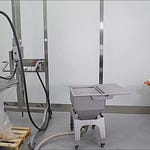Reusing leftover fermented dough has evolved significantly in recent years. While traditionally viewed with caution, recent research and industrial practices demonstrate considerable benefits when properly managed. From enhanced flavor to environmental sustainability, incorporating leftover dough can positively impact bakery products, reduce waste, and improve profitability.
Why Reconsider Leftover Dough?
Historically, leftover dough—often called "rework"—was cautiously reused in small quantities (usually under 10% of flour weight) due to fears of product quality loss and contamination risks. However, rising ingredient costs and increased sustainability awareness have incentivized bakeries to revisit these practices.
Controlled fermentation of rework can not only mitigate quality issues but significantly enhance the final product. Through proper handling and targeted fermentation, leftover dough is transformed from waste into a beneficial ingredient, enhancing flavor, shelf life, and texture.
Benefits of Using Fermented Rework Dough
1. Enhanced Flavor and Aroma
Controlled fermentation creates organic acids and aromatic compounds, enriching bread flavor:
Fermented dough introduces complexity and subtle acidity.
Products like pizza dough and pastries gain a deeper, richer taste.
Even minimal quantities (around 7%) can significantly boost sensory qualities.
2. Improved Texture and Shelf Life
Fermentation naturally conditions dough, improving its texture and prolonging freshness:
The presence of acids and dextrans, primarily produced by beneficial lactic acid bacteria such as Weissella confusa and Lactobacillus species during fermentation, softens the crumb and improves extensibility by modifying the gluten network and increasing water retention within the dough.
Products using fermented dough remain softer longer and resist staling.
Enhanced shelf life reduces waste and improves customer satisfaction.
3. Sustainable and Cost-Effective
Reducing dough waste aligns with broader environmental sustainability goals:
Incorporating dough scraps decreases bakery waste significantly.
Financial savings are achieved by minimizing ingredient disposal.
The environmental footprint of bakeries is notably reduced.
Best Practices for Dough Reuse
Successful incorporation of leftover dough requires careful practices:
Consistent Ingredients:
Always mix leftover dough into identical dough formulations.
Avoid cross-contamination risks by ensuring allergen profiles match precisely.
Proper Storage Conditions:
Quickly refrigerate leftover dough scraps to slow fermentation.
Never store dough scraps at room temperature for extended periods to avoid off-flavors.
Controlled Incorporation Levels:
Initially limit addition to 5-10% if using unfermented rework.
This refers to dough scraps that have not undergone additional fermentation beyond their original batch.
At this stage, the dough still contains active yeast and residual fermentation by products, which may behave unpredictably.
Using more than 10% can over-acidify the new dough, disrupt gluten development, cause irregular gas retention, and lead to off-flavors.
Limiting the amount reduces the risk of structural and sensory defects, ensuring the base dough maintains proper strength and balance.
Gradually increase quantities (up to 20-25%) when properly fermenting dough scraps.
When dough scraps are treated like a preferment (e.g., pâte fermentée or sourdough) and fermented under controlled conditions, they become more stable and functional.
Fermentation by beneficial lactic acid bacteria reduces undesirable effects, improves structure, and enhances the dough’s contribution to the final product.
In these cases, higher incorporation levels are not only safe but can improve aroma, shelf life, and crumb structure.
Uniform Mixing Techniques:
Integrate dough scraps early in mixing for even distribution.
Monitoring Dough Strength:
Regularly adjust hydration and yeast levels to maintain dough consistency.
Keep precise records of dough conditions to replicate successful batches.
Source: https://tinyurl.com/3d2y7kcs











